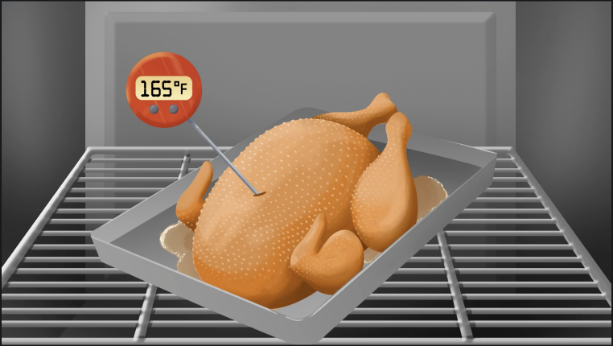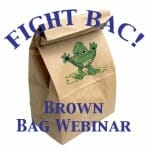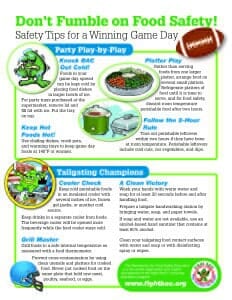Salmonella, Campylobacter and other harmful bacteria live on raw chicken.
Washing or rinsing doesn’t remove this: worse, it helps the bacteria spread. When you add water through washing or rinsing, you give this bacteria a way to travel throughout your kitchen.
Today’s poultry is already pretty clean. Our grandparents may have been cooking chicken that had some unsavory things on it, like waste or feathers. Today’s manufacturing cleans the chicken, so there is no filth, feathers, or anything else on it that needs to be washed off. Poultry may have a coating of water and protein: this gets cooked off, or you can remove it with a clean paper towel. Anything that is on the chicken will get cooked off.
Use a clean paper towel.
If you see anything on the chicken you want to get rid of, wipe it off with a clean paper towel.
Never rinse or wash chicken.
Raw chicken and juices should touch as few things as possible.
Separate raw chicken from fresh and ready-to-eat foods. Keep surfaces clean by washing them with hot, soapy water.

Cook it to 165 °F.
Cooking the chicken to 165 °F using a digital food thermometer will kill any dangerous bacteria, and make it safe to eat.
Young children and adults aged 65+ are more likely to get sick and be hospitalized from germs that cause foodborne illness.
Simple poultry handing steps will help you reduce the risk of illness from common germs that can cause food poisoning, such as Salmonella and Campylobacter.
Learn how to practice safe poultry handling
at the store and at home.
Are you aware that illnesses from Salmonella spike in the summer?
You can have a summer without Salmonella by following easy safe food handling steps!
Download Postcards (English and Spanish)
Download Flyer (English)
Download Flyer (Spanish)
Download PowerPoint
While warmer temperatures mean fun activities like barbecues and picnics, these activities call for particular attention to food safety steps.
These shareable resources social media graphics and downloadable flyer remind consumers what internal temperatures chicken and popular grilling meats need to reach to be safe.
Check out these safe recipes that feature chicken, turkey and other delicious ingredients! Our recipes build in food safety and hand hygiene steps provided by the Safe Recipe Style Guide.
Research shows that adding food safety instructions to recipes improves consumer food safety behaviors. Give these delicious dishes a try at home!

Resources for health and food safety educators

Print and digital resources for retailers

Consumer information in English and Spanish
Don’t Wash Your Chicken is based upon work that is supported by the National Institute of Food and Agriculture, U.S. Department of Agriculture, Agriculture and Food Research Initiative Competitive Grant No. 2019-68008-29908.
Any opinions, findings, conclusions, or recommendations expressed in this publication are those of the author(s) and do not necessarily reflect the view of the U.S. Department of Agriculture.
© 2022 New Mexico State University Board of Regents, Drexel University and New Mexico State University cooperating with the U.S. Department of Agriculture. Drexel University and NMSU are both equal opportunity/affirmative action employers and educators.



Recordings of Webinars & Knowledge Exchanges Hosted by PFSE
Simply click the video to connect to the associated YouTube video or audio recording. If CEU certificates are not listed, CEUs were not offered for that event or CEUs have expired. Thank you for your interest in our events! Be sure to sign up for our weekly emails to get advance notice of events.
Recorded live on February 29, 2024
Presenters: Dr. Elisabetta Lambertini, Global Alliance for Improved Nutrition; Carrie Taylor, RDN, KYT, KMOG, Big Y Foods; Raeanne Sarazen, MA, RDN, Culinary Nutrition Consulting
Recorded live on November 1, 2023
Presenters: Jane DeMarchi, North American Millers Association; Fanfan Wu, Ph.D., U.S. Food and Drug Administration; Sharmi Das, U.S. Food and Drug Administration; and Katie Weston, Partnership for Food Safety Education
Recorded live on August 17, 2023
Presenters: James E. Rogers, Ph.D., Director, Acting Head of Product Safety Testing, Consumer Reports; Kelsey Schwarz, Ph.D., Health Communications Specialist, Centers for Disease Control; Sara Bresee, MPH, Health Communications Specialist, Centers for Disease Control; and Barbara Chamberlin, Ph.D., Director, Innovative Media Research and Extension Department, New Mexico State University
Recorded live on June 7, 2023
Presenters: Julie V. Wood, CPM and Joseph A. Smith III,
Florida Department of Agriculture; Mychelle Garrigan, Firelink Digital Marketing; and Katie Weston, Partnership for Food Safety Education
Recorded live on February 16, 2023
Presenters: Nicole Arnold, Ph.D., Ohio State University Extension; Allison Howell, Ohio State University Extension; Ayma Rouhani, MPH, U.S. Food & Drug Administration; Cynthia Aspengren, The University of Arizona; and Katie Weston, Partnership for Food Safety Education
Recorded live on August 11, 2022
Presenters: Dr. Jennifer Quinlan, Drexel University; Adrian Aguirre, New Mexico State University; Melissa Wyatt, MS, MA, Food & Nutrition Professional; and Shawnte Loeri, Partnership for Food Safety Education
Recorded live on May 12, 2022
Presenters: Harold Chase, NSF International and PFSE Vice-Chair of Board of Directors; Amy Lando, MPP, U.S. Food and Drug Administration; and Britanny Saunier, Partnership for Food Safety Education
Recorded live on March 2, 2022
Presenters: Dr. Ellen Shumaker, North Carolina State University; Katie Weston, Partnership for Food Safety Education; and Chef Leslie Owens, Partnership for Food Safety Education
Recorded live on October 6, 2021
Presenters: Meredith Carothers, MPH, USDA Food & Safety Inspection Service; Vincent Hill, PhD, PE, Chief, Waterborne Disease Prevention Branch, CDC; Mindy Costello, Scrub Club Program Manager, NSF International; and Katie Weston, Partnership for Food Safety Education
Recorded live on August 25, 2021
Cohosted by the Association of Food & Drug Officials (AFDO), this webinar highlights the brand-new food delivery campaign Prep Yourself: Food Is on the Way. Presenters: Shelley Feist, former Executive Director of PFSE; Steven Mandernach, Executive Director of AFDO; and Allison Beadle, RD, Founder & CEO of Wild Hive.
Recorded live on July 14, 2021
During this knowledge exchange, we opened a conversation with BAC Fighters on the top safety questions related to home canning. Our guest was Dr. Elizabeth Andress, professor emerita of University of Georgia and former Director of National Center for Home Food Preservation.
CEUs are not offered for this presentation.
Recorded live on September 9, 2020
Presenters: Sally Squires, MS, MS, award-winning former health and medical reporter for the Washington Post; and Shelley Feist, Executive Director, Partnership for Food Safety Education
Recorded live on August 5, 2020
Presenters: David Fikes, Executive Director, FMI Foundation; Shelley Feist, Executive Director, Partnership for Food Safety Education; and Katie Weston, Community Engagement Manager, Partnership for Food Safety Education
Recorded live on July 2, 2020
Presenters: Jennifer McEntire, PhD, Vice President, Food Safety & Technology, United Fresh Produce Association and Trevor Suslow, Vice President of Produce Safety with the Produce Marketing Association
CEUs are not offered for this presentation.
Recorded live on May 13, 2020
Presenters: Dr. Mindy Brashears, Deputy Under Secretary for Food Safety, U.S. Department of Agriculture; Dr. Ashley Peterson, Senior Vice President, Scientific and Regulatory Affairs, National Chicken Council; Dr. KatieRose McCullough, Director, Regulatory and Scientific Affairs, North American Meat Institute
Recorded live on December 5, 2019
Presenters: Jennifer McEntire, PhD, Vice President, Food Safety & Technology, United Fresh Produce Association and Trevor Suslow, Vice President of Produce Safety with the Produce Marketing Association
Recorded live on November 19, 2019
Presenters: Donald Kautter, Senior Advisor/Consumer Safety Officer with the FDA; Sharon Davis, Family and Consumer Sciences Educator, Home Baking Association
Recorded live on October 15, 2019
Presenters: Dr. Mindy Brashears, U.S. Department of Agriculture’s Food Safety and Inspection Service; Dr. David Berendes, Centers for Disease Control and Prevention; Ashley Andújar, Centers for Disease Control and Prevention; Glenda Hyde, Oregon State University Extension; Jolly Elementary School in Clarkston, GA; and Bruce-Munroe at Park View Elementary School in Washington, DC (Spanish immersion school)
Recorded live on June 12, 2019
Presenters: Mindy Costello, RS, MS, Consumer Informaton, NSF International; Dr. Akrum Tamimi, Professor of Practice, Department of Biosystems Engineering, The University of Arizona; Dr. Shauna Henley, FCS Agent, University of Maryland Extension, Board Member, Partnership for Food Safety Education
Recorded live on May 15, 2019
Presenters: Dr. David Berendes, Epidemiologist, Global WASH Team, Division of Foodborne, Waterborne, and Environmental Diseases, Centers for Disease Control and Prevention; Dr. Akrum Tamimi, Professor of Practice, Department of Biosystems Engineering, The University of Arizona; Shelley Feist, Executive Director, Partnership for Food Safety Education
Recorded live on April 24, 2019
Presenters: Steven Mandernach, JD, Executive Director, Association of Food and Drug Officials; Kemi Oni, MPH, Epidemiologist, Iowa Department of Public Health
Recorded live on February 14, 2019
Presenters: Dr. Megin Nichols, Enteric Zoonoses Activity Lead, Centers for Disease Control and Prevention and Lauren Stevenson, Epidemiologist/Health Communicator, Centers for Disease Control and Prevention
Recorded live on October 30, 2018
Presenter: Marianne H. Gravely, MS, Senior Technical Information Specialist, USDA Meat and Poultry Hotline
Recorded live on October 4, 2018
Presenters: Kelley Dennings, Past-President, Social Marketing Association of North America, Director of Social Marketing, Action Research; Richard Mathera, Senior Behavioral Scientist, Common Cents Lab; Alexandra Bornkessel, Program Director, Social Innovation and Digital Strategy, RTI International; Dr. Christine Prue, Associate Director for Behavioral Science, Centers for Disease Control and Prevention
Recorded live on September 12, 2018
Presenters: Sue Borra, Food Marketing Institute and FMI Foundation; Maya Maroto, U.S. Food and Drug Administration; and Eric Davis, FLM Harvest
Recorded live on June 20, 2018
Presenters: Alexandra Bornkessel, Senior Strategist, RTI International, and Kelley Dennings, President, Social Marketing Association of North America
Recorded live on June 6, 2018
Presenter: Angela Fraser, Associate Professor, Food, Nutrition and Packaging Sciences Department, Clemson University
www.fightbac.org/kids
Recorded live on April 18, 2018
Presenters: Richard Mathera, Senior Behavioral Scientist at Common Cents Lab, and Tracey Haldeman, Board Member, Social Marketing Association of North America
Recorded live on March 21, 2018
Presenters: Dr. Barbara Kowalcyk, Assistant Professor, The Ohio State University, The Center for Foodborne Illness Research & Prevention, and Michael Batz, Operations Research Analyst, U.S. Food and Drug Administration
Recorded live on February 15, 2018
Presenters: Kelley Dennings, Director of Social Marketing, Action Research, and Andrew Lentini, Treasurer, Social Marketing Association of North America
Recorded live on January 16, 2018
During this knowledge exchange, we opened a conversation with BAC Fighters about how safe food handling practices at home connect with the desire of many consumers to reduce food waste. Our guest was Howard Seltzer, a National Food Safety Education Advisor with the U.S. Food and Drug Administration.
How to Cut Food Waste and Maintain Food Safety
CEUs are not offered for this presentation.
Recorded live on July 27, 2017
Recorded live on June 8, 2017
Recorded live on May 18, 2017
Recorded live on April 18, 2017
Recorded live on March 16, 2017
 As you head out to tailgate before the big game, remember food safety is key to defeat BAC! (foodborne bacteria).
As you head out to tailgate before the big game, remember food safety is key to defeat BAC! (foodborne bacteria).
The Play by Play
Grilling All-Stars
Be a grilling all-star at your tailgate by keeping food safe. Follow these tips to make a great play at the grill:
Clean your Way to Victory
Your Food Safety Game Plan
Be sure to have the following items on hand before the big game:
Resources
If you have more questions or concerns about food safety, contact:
The Partnership for Food Safety Education is a non-profit organization and creator and steward of the Fight BAC!® consumer education program. The Partnership is dedicated to providing the public with science-based, actionable recommendations for the prevention of foodborne illness.

Download our Flyer: Don’t Fumble on Food Safety

 A true “Grill Master” always knows to clean, separate, cook and chill to ensure a pleasant cookout for all.
A true “Grill Master” always knows to clean, separate, cook and chill to ensure a pleasant cookout for all.
Resources
If you have more questions or concerns about food safety, visit these websites:
 When eating outside while traveling or picnicking away from home, it’s important to take along the basic food safety necessities and follow these tips to reduce risk of foodborne illness:
When eating outside while traveling or picnicking away from home, it’s important to take along the basic food safety necessities and follow these tips to reduce risk of foodborne illness:
Resources
If you have more questions or concerns about food safety, contact:
The Partnership for Food Safety Education is a non-profit organization and creator and steward of the Fight BAC!® consumer education program. The Partnership is dedicated to providing the public with science-based, actionable recommendations for the prevention of foodborne illness.